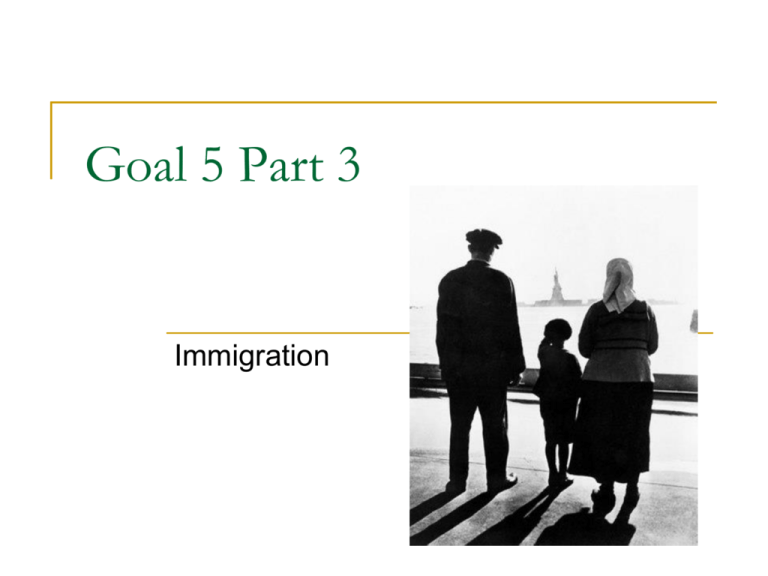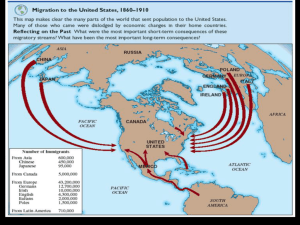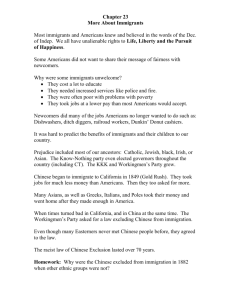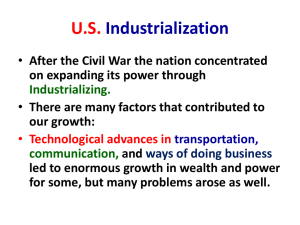Goal5Part3 - ashtonushistory
advertisement

Goal 5 Part 3 Immigration Why come to America? Escaping religious, economic and religious persecution 1870-1920 = 20 million European immigrants America – land of opportunity Immigration Patterns Before 1890 (Old Immigrants) came from WESTERN and NORTHERN Europe After 1890 (New Immigrants) came from SOUTHERN and EASTERN Europe Immigrants = “birds of passage” U.S. (New Immigrants)– “open arms!!!” Why? Immigration stations Ellis Island *GOLDEN DOOR Chief immigration station from 1892-1924) inspection station at New York Harbor (East Coast) (Europeans) / 1 2 million European immigrants Barn-like structure **Northeast and Midwest America – experienced the FASTEST growth due to immigration! Angel Island Asians, primarily Chinese, West Coast Ellis Island (Golden Door) Inspection Station Melting Pot - “Melting Pot” describes America as a mixture of culture and people who blended together Side effect = NATIVISM (introduced by KnowNothing Party) Nativism - anti-immigrant feeling Religion– differences in religion caused “nativism” to be an issue more than anything else! U.S BEGINS TO THINK ABOUT RESTRICTIONS!!!! Immigration Restriction *Prescott Hall (1894) – founded the Immigration Restriction League points out the “Right” and “Wrong” countries Right – Britain, Germany, Scandinavian, (progressive/energetic –can help American economy) Wrong – Any Latin country (stagnant –cannot help American economy) Chinese Exclusion Act (1882) Gentlemen’s Agreement (1907-1908) Chinese Exclusion Act (1882)- FIRST major federal law LIMITING immigration to the U.S. banned all entry of the Chinese except students, teachers, doctors Main reasoning? Gentlemen’s Agreement (1907-1908) – Story: Japanese students were in segregated schools in California Agreement: Japanese government limited immigration into America IF Japan and U.S could agree to lift segregated schools!!!! Chinese Exclusion Act Urbanization Urbanization - the growth of cities Why would immigrants settle in the cities? -cheapest place to live -offered jobs to unskilled workers *Side effect of urbanization: leads to URBAN PROBLEMS!!!! Other Urban Problems (SIDE EFFECT OF URBANIZATION) Transportation – fixed by “mass transit” systems (Subway, Trolley) Water – chlorination filters Sanitation – developed sewer lines and sanitation departments Crime – police forces Fire – fire departments Housing problems How the Other Half Lives BY: Jacob Riis - points out the multifamily urban-dwelling lifestyle (tenements) / (overcrowded and unsanitary) Tenements – overcrowding and unsanitary urban housing (NO EDUCATION) T.Q. Where was the source of the GREATEST number of immigrants to the United States in early 1900? a. Southern and Eastern Europe b. Northern and Western Europe c. Mexico and California d. China and Japan Urban Problems Social Welfare Reformer Settlement Houses led mostly by **JANE ADAMS** (HULL HOUSE) (most famous) Settlement Houses - community centers that assisted “poor immigrants” / provided educational, cultural, and social expectancies to fit into American society. (ASSIMILATION/AMERICANIZTION) *Difference between Tenement and Settlement House??? Jane Adams’ Hull House, Chicago Illinois Hull House Ghost Immigrant Journey E.Q. Analyze the immigrant journey by evaluating the emotional and physical rollercoaster they experienced while arriving in America









